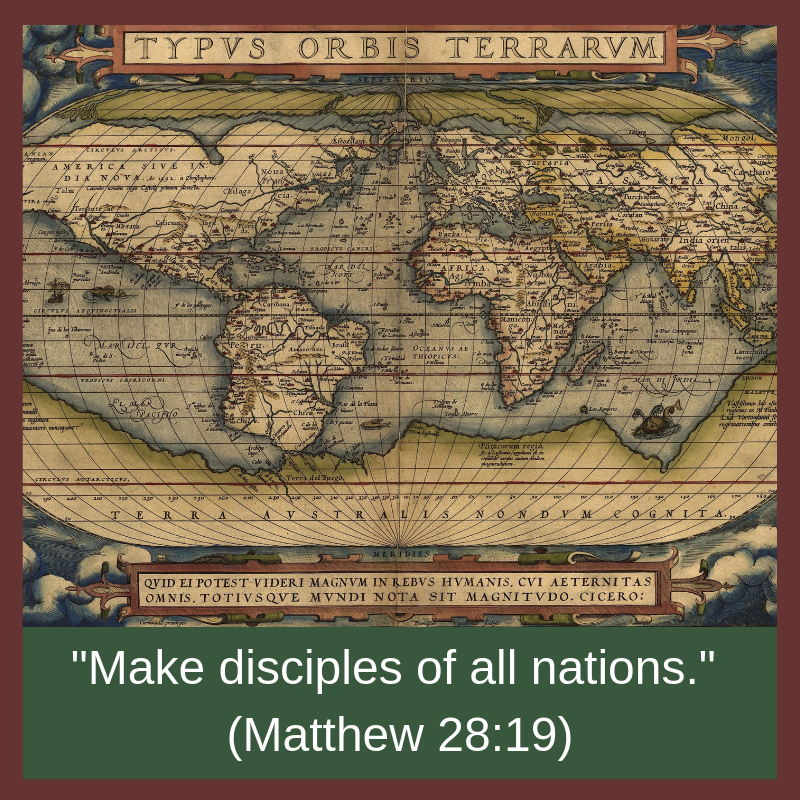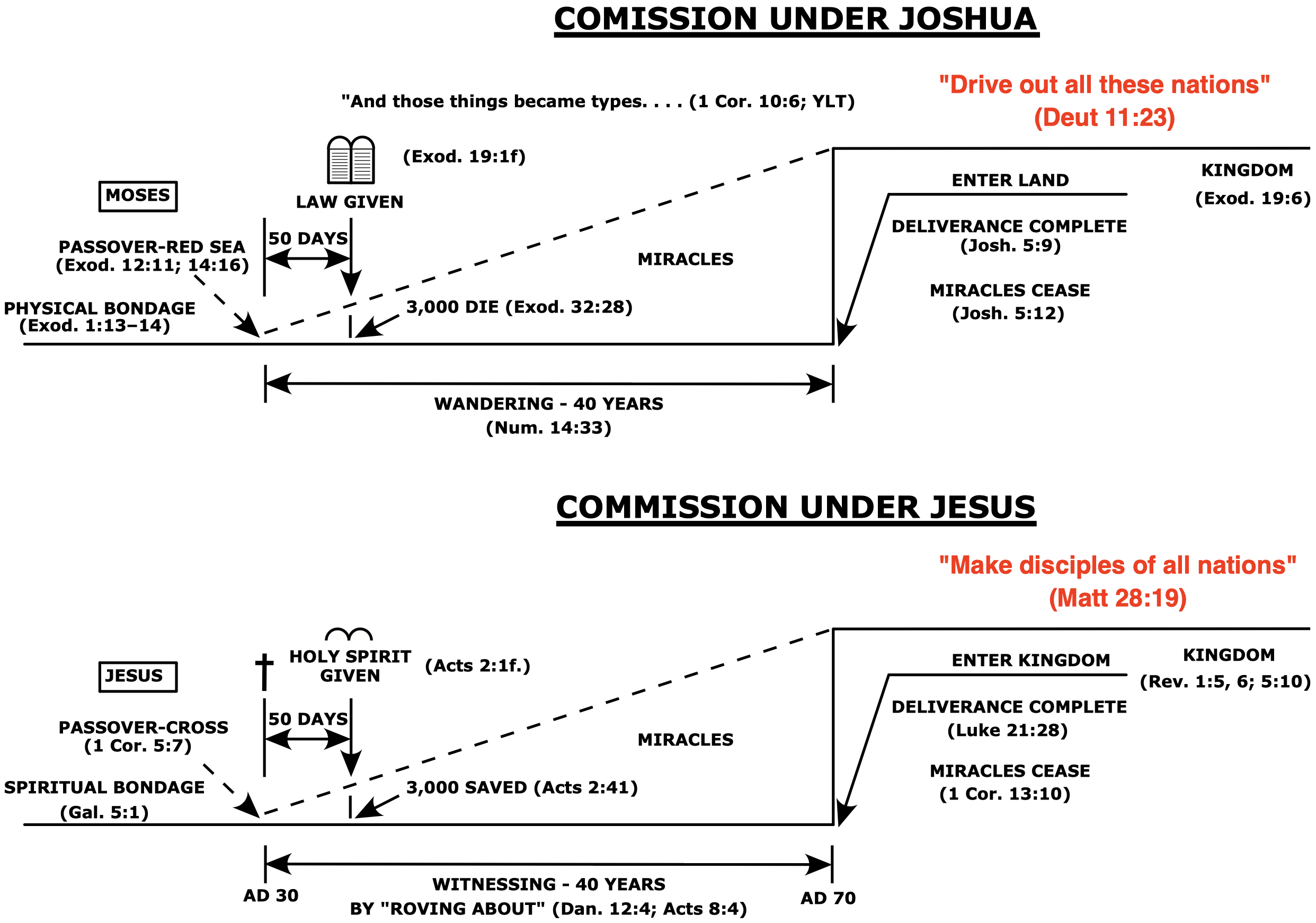
Recent posts in our Mediations in Matthew series have looked at Jesus’ accomplishments in his death, burial, and resurrection (Matt 27–28). Through these events, he erected a new Temple (here) and redefined Israel (here). In our last post (here), we said Jesus accomplished the true Exodus.
Paul authorized the comparison of Jesus’ Exodus to that of Moses (1 Cor 10:1–13). Moses delivered all members of “Israel after the flesh” (1 Cor 10:18) from bondage to physical slavery. This was a type (or picture) of the church (1 Cor 10:6, 11). In the antitype (or reality), Jesus’ Exodus delivered all the “Israel of God” (Gal 6:16) from bondage to sin and death (e.g., Heb 2:15).
This post will extend this exodus-typology. At his second rehearsal of God’s law, Moses spoke of Israel possessing the land of Canaan. He said,
If you carefully keep all these commandments which I command you to do—to love the LORD your God, to walk in all His ways, and to hold fast to Him—then the LORD will drive out all these nations from before you, and you will dispossess greater and mightier nations than yourselves. (Deut 11:22–23; emphasis added)
Jesus provided the antitype in his Great Commission.1 After his resurrection he said:
All authority in heaven and on earth has been given to me. Go therefore and make disciples of all nations, baptizing them in the name of the Father and of the Son and of the Holy Spirit, teaching them to observe all that I have commanded you. And behold, I am with you always, to the end of the age. (Matt 28:18–20; emphasis added)
Plotting these commissions on the diagram from last week’s post yields:

We will consider three elements of Jesus’ commission: its vision, tactics, and prophetic background. Our discussion will draw on the above typology.
Vision
We are using “vision” as a description of a future reality. In this sense, Israel’s vision was clear. As they followed Moses’s successor, Joshua, across the Jordan River, they knew God had
come down to deliver them out of the hand of the Egyptians, and to bring them up from that land to a good and large land, to a land flowing with milk and honey, to the place of the Canaanites and the Hittites and the Amorites and the Perizzites and the Hivites and the Jebusites. (Exod 3:8)
A time would come when these six nations would no longer control the land. Israel knew that, in the future, they would enjoy the land’s bounty. They would live there under God’s government. This was their expected existence.
Israel’s vision did not rest on speculation. God had revealed it through his Word to Moses. The Exodus was more than release from slavery. It had been the first step necessary for Israel to live in the Promised Land. God had said they would do so. The vision depended on the truthfulness of his revelation.
The New Testament Israel of God (i.e., the church) also has a vision. In this vision, all nations worship the true and living God through our Lord Jesus Christ. This vision did not spring from the mind of man. It comes from God.
This is a messianic-age vision. Jesus’ true Exodus has freed his people from slavery to sin and death. But that is not the end of his Exodus story in history. God has said his redeemed people will “make disciples of all nations” in the kingdom of God.
God established this kingdom in the days of the Roman kings. It will overcome and consume all other kingdoms (Dan 2:44).
As part of his Exodus, Jesus ascended in the clouds after his resurrection. He went to the Father to receive the kingdom. As a result, “all peoples, nations, and languages [will] serve Him” (Dan 7:13–14; cp. Acts 1:9).
Israel’s new vision rests on the fact that God has enthroned Christ as his King in Zion. He will now give him the nations for his inheritance and the ends of the earth for his possession (Ps 2:6–8).
The list of passages showing this vision is long. Here are a few more from the Psalms:
All the ends of the world shall remember and turn to the LORD, and all the families of the nations shall worship before You. For the kingdom is the LORD’s, and He rules over the nations. (Ps 22:27–28; emphasis added)
All the earth shall worship You and sing praises to You; they shall sing praises to Your name. Selah (Ps 66:4; emphasis added)
His name shall endure forever; His name shall continue as long as the sun. And men shall be blessed in Him; all nations shall call Him blessed. (Ps 72:17; emphasis added)
God’s vision for his church is well-defined. Typical Israel under Moses envisioned a fruitful land under their control. Antitypical Israel (i.e., the church) envisions a world full of nations serving God through Christ.
Tactics
God commissioned Israel to accomplish their vision. He said, “drive out all these nations from before you” (Deut 11:23; emphasis added). Joshua and his army knew the land of their vision was “the place of the Canaanites and the Hittites and the Amorites and the Perizzites and the Hivites and the Jebusites” (Exod 3:8). These nations did not want to leave their possessions.
So, the vision required warfare. Israel had to defeat these nations to make the vision a reality. God said he would enable them to do so. He said, “Observe what I command you this day. Behold, I am driving out from before you the Amorite and the Canaanite and the Hittite and the Perizzite and the Hivite and the Jebusite” (Exod 34:11).
The faithful in Israel expressed confidence that their vision would become a reality. For example, the spies told Rahab, “It shall be, when the LORD has given us the land, that we will deal kindly and truly with you” (Josh 2:14). Their word was when not if.
Israel’s tactical strategies to achieve their vision involved weapons. The army paraded in arms (Josh 1:14; cp. Josh 4:12–13; 6:7; etc.). When Jericho’s walls fell, Israel “utterly destroyed all that was in the city, both man and woman, young and old, ox and sheep and donkey, with the edge of the sword” (Josh 6:21).
The messianic-age vision also involves warfare. But now the enemies are not ethnic groups. To achieve the messianic-age vision, God’s people “do not wrestle against flesh and blood, but against principalities, against powers, against the rulers of the darkness of this age, against spiritual hosts of wickedness in the heavenly places” (Eph 6:12).
Christ’s armies no longer resort to physical weapons. Paul said,
Though we walk in the flesh, we do not war according to the flesh. For the weapons of our warfare are not carnal but mighty in God for pulling down strongholds, casting down arguments and every high thing that exalts itself against the knowledge of God, bringing every thought into captivity to the obedience of Christ. (2 Cor 10:3–5; emphasis added)
The Israel of God (Gal 6:16) uses different tactics than did Israel after the flesh (1 Cor 10:18). They overcome their enemies “by the word of truth, by the power of God, by the armor of righteousness on the right hand and on the left” (2 Cor 6:7).
Israel now uses spiritual armor: a girdle of truth, a breastplate of righteousness, gospel-of-peace shoes, the shield of faith, the helmet of salvation, and the sword of the Spirit, which is the word of God (Eph 6:14–17).
Prayer is a weapon God will use to achieve the messianic-age vision. Jesus taught his army to pray, “Our Father in heaven, hallowed be Your name. Your kingdom come. Your will be done on earth as it is in heaven.… For Yours is the kingdom and the power and the glory forever” (Matt 6:9–10, 13; emphasis added). He will answer this prayer.
Jesus’ commission specifies its tactics. His ministers are to “preach the gospel to every creature” (Mark 16:15). They are to baptize those who believe “in the name of the Father and of the Son and of the Holy Spirit, teaching them to observe all that” Jesus commanded (Matt 28:19–20).
Ministers organize these baptized believers into churches. They ordain elders in each one (Acts 14:23; Titus 1:5). These churches then become centers of missionary operation. They send ministers to preach the gospel of the kingdom (Acts 13:1–3; 1 Thess 1:6–8).
This creates a cycle. Churches send ministers. Ministers preach the gospel and make disciples. These disciples become churches. These churches send ministers. Etc.
This is how God will accomplish our messianic-age vision. The above cycle will continue until the day Jesus has
dominion also from sea to sea, and from the River to the ends of the earth. Those who dwell in the wilderness will bow before Him, and His enemies will lick the dust. The kings of Tarshish and of the isles will bring presents; the kings of Sheba and Seba will offer gifts. Yes, all kings shall fall down before Him; all nations shall serve Him. (Ps 72:8–11; emphasis added)
Prophecies
Several Old Testament passages show the sequence of events necessary to achieve this vision. Zechariah provides one example. First, the King comes to Jerusalem:
Rejoice greatly, O daughter of Zion!
Shout, O daughter of Jerusalem!
Behold, your King is coming to you;
He is just and having salvation,
Lowly and riding on a donkey,
A colt, the foal of a donkey. (Zech 9:9)
Then, God judges Israel:
I will cut off the chariot from Ephraim
And the horse from Jerusalem;
The battle bow shall be cut off. (Zech 9:10a)
Then he converts the nations:
He shall speak peace to the nations;
His dominion shall be ‘from sea to sea,
And from the River to the ends of the earth.’ (Zech 9:10b)
Other Old Testament prophecies show this sequence will occur in the “last days” (Heb 1:2) of the Mosaic age. Here is one example:
Now it shall come to pass in the latter days [i.e., of the Mosaic age] that the mountain of the LORD’s house shall be established on the top of the mountains, and shall be exalted above the hills; and all nations shall flow to it. (Isa 2:2; emphasis added)
Inmillennialism depicts this sequence and timing. A previous post showed them in Revelation (here).
Conclusion
We must not separate Jesus’ “Great Commission” from the Bible’s kingdom-vision. “This mission of God’s people within the world is to be understood within an eschatological perspective, that is, it is grounded in the saving events of the gospel and keeps an eye on the final goal.”2 Jesus’ commission carries its vision—a world of nations serving him.
This messianic-age vision is consistent across both covenants. The Old Testament says Jesus must sit at God’s right hand until all his enemies are subdued (Ps 110:1). The New Testament then quotes this verse more than any other. Paul provides a key insight. Christ overcomes death in the resurrection. It is his last enemy (1 Cor 15:25-26).
Christ is reigning now. He has given us a vision for his kingdom. It is of a world filled with nations that serve him. He has given us a “Great Commission” to turn that vision into a reality. And, as God promised to be with Israel as they fought for the Promised Land, so has Jesus promised to be with his church during her spiritual warfare. She will complete the Great Commission to the glory of God.
Footnotes
- The image in this post is Ortelius World Map Typvs Orbis Terrarvm, 1570 by Abraham Ortelius (1527–1598) . This file (here) is in the public domain (PD-US).
- Andreas J. Köstenberger and Peter Thomas O’Brien, Salvation to the Ends of the Earth: A Biblical Theology of Mission (Downers Grove, IL: InterVarsity, 2001), 269.
